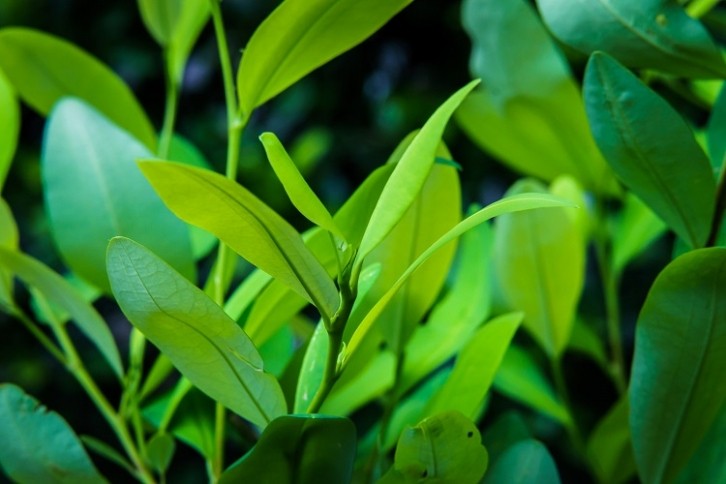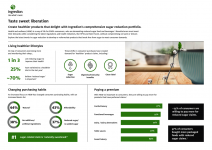Cutting sugar in drinks with ‘the most illicit plant in the world’

The coca plant is best known for its psychoactive alkaloid, cocaine. In its de-cocainised form, the plant is also used to flavour the best-selling soda in the world, Coca-Cola.
But now coca leaf extracts are finding a different purpose: one completely disassociated from both the drug trade and full-sugar beverages.
In fact, this new function aims to reduce the sugar content in sugar-sweetened beverages, with its maker – Power Leaves – claiming it can cut sugar content in drinks by up to 40%.
How sugar reduction tech is made from coca
The sugar reduction technology is made from the leaf of the coca plant. Canada-headquartered Power Leaves extracts the coca with ethanol and purified water, and destroys the coca alkaloids. The company has even hired a third-party to verify the resulting coca is completely free-from illicit and controlled narcotic elements.
The ethanol is removed via a distilling process, which leaves Power Leaves with its primary product, coined Coca X. The ingredient, which Power Leaves claims can significantly reduce sugar content in beverages, is perhaps more accurately described as a flavour enhancer.
It enhances sweetness while reduces bitterness, explains CEO Pat McCutcheon, describing the flavour as ‘bold’. “You immediately sense the cola-esque, wintergreen flavour.”
Some have picked up on vanilla notes or different fruit flavour profiles. However, the overwhelming response from research and development trials with industry partners is that Coca X should be used as a standalone flavour ingredient. “We constantly get feedback that it should be used on its own, because it’s such a strong and unique flavour. It’s a very bold flavour, that can overpower other sweet fruit flavours such as lemon or strawberry.”
Targeting the beverage market, but not a threat to Coca-Cola
In offering a ‘cola-esque’ flavour, it’s perhaps unsurprising that Power Leaves is firstly targeting the beverage sector. But that’s not to say it’s looking to conquer sodas with a cola competitor, it’s not.
The company expects the first products to land on-shelf containing its Coca X ingredient to come from the energy drink, or sparking or hydration water categories. In masking bitterness and allowing for up to 40% sugar reduction, the ingredient works well with bitter caffeine in energy drink formulas.
“Our company partners can develop an energy drink with the same performance as a sugary competitor, but with significantly less bitterness from the caffeine side,” explains McCutcheon.

Even though Power Leaves is separating itself from the cola-flavoured soda category, the company is pretty sure the biggest name in cola is aware of its work. Coca-Cola is likely not to perceive Power Leaves as a threat to its brand, however.
“We’re a small company that’s scaling up and positioning itself out of Colombia. We’re not competing with [Coca-Cola’s] Peruvian supply chain. At this point, we don’t feel that we’re a potential risk to Coca-Cola.
“If anything, one of our value propositions to shareholders is to create a system where we will be attractive enough to have a major player such as Coca-Cola look at us as a potential partner, rather than a competitor.”
Is Power Leaves competing with the drug trade?
The coca plant is native to South America. In Colombia, where Power Leaves sources its coca, it’s grown wild – rather than in commercial plantations. Harvesting is done by hand, which given the climate required for coca cultivation, McCutcheon describes as an ‘incredibly efficient’ process.
The region is incredibly mountainous. “One of the competitive advantages we have, and it’s unique to the plant, is that coca grows well in different elevations and microclimates. In such a mountainous region it’s difficult to apply industrial equipment to harvest. It also gives us the ability to support many families as we scale this project up.”
Once harvested, the leaf drying process is undertaken on the farm. Power Leaves has supported its indigenous partners to set up large, commercial drying units which McCutcheon describes as ‘outdoor drying tunnels’. The leaves, once dried, are packed on-farm, and stored at the company’s facilities in preparation for coca extraction.
As to whether Colombian farmers are also selling coca leaves into the drugs trade, meaning that Power Leaves would be competing with cocaine dealers, the answer is no. It’s a question McCutcheon is often asked.
“We feel very strongly that we aren’t competing against leaf supply that goes into the illicit factions,” he tells this publication. The reason being that coca leaf cultivation has grown significantly over the last couple of decades, meaning that coca supply now outpaces demand of even the cocaine sector.
Cocaine production and Coca-Cola flavouring are far from the only uses of the coca leaf. Indigenous populations have chewed coca leaves for centuries, claiming the plant has medicinal qualities, such as relieving the effects of altitude sickness.
The Colombian Government, under the guidance of President Gustavo Petro, is supportive of its indigenous population finding new and sustainable long-term economic ventures, says McCutcheon, who sees an obvious solution in the coca plant.
Compared to other tropical crops such as coffee or cocoa, coca can turn around yields in a shorter time frame, with between three to four harvests per year. The shrub is perennial and has a lifespan of anywhere between 70-100 years. “It’s a very prolific producer, and for a number of different reasons, presents a sustainable, long-term opportunity for indigenous groups.”
Tackling the coca stigma with indigenous partners
The challenge, for all involved, lies in tackling the obvious stigma around coca leaves, which has long been tied to production of one of the most controlled substances in the world.

Power Leaves considers itself the first international company in the world to successfully sign an exclusive agreement with indigenous partners in Colombia – the Nasa – located around seven hours south of the country’s capital. The Nasa, also known as the Páez, are one of Colombia’s largest indigenous peoples.
This relationship is the ‘true value proposition’ of the company, says McCutcheon, who hopes that working within Colombia with this ‘brand-new industry’ will help combat the coca stigma. “It’s really been the most illicit product in the world from a plant perspective,” he admits.
Power Leaves is working with ‘tier one’ beverage brands and ingredients distributors to scale up ingredient production, and hopes to see first products on the market by the end of the year.
Power Leaves eyes European expansion
Coca X is not the only ingredient in Power Leaves’ pipeline. The company is simultaneously working on a 70%-plus ethanol ingredient it’s coined Coca E. “It’s our first waste stream product,” explains McCutcheon. “It gives you a very unique aroma and modifying flavour profile that can be used for different alcoholic beverages and ready-to-drink products.”
Coca E is described as offering a more ‘refined’ flavour compared to Coca X, which makes it a better fit for alcohol-based spirits. “Whether you use it with a vodka or gin or tequila, it has a unique flavour modulating effect. It’s difficult to nail down exactly what it tastes like when you look at it independently, because it gives a different flavour depending on the spirit.”
The company also sees potential for protein isolation of coca (the leaf contains more than 20%-plus protein) down the line.
Although initial market focus is centred around North America – Coca X is GRAS (generally recognised as safe) certified – Power Leaves expects to see European expansion soon after. Coca X is a non-novel food flavour ingredient, says McCutcheon.
“Europe will be our second market in terms of commercialisation, and we expect to be on sale in both regions in 2024.”
In the meantime, Power Leaves has plans to go public with the Toronto-based Cboe Canada stock exchange, before moving onto the US Cboe exchange and international exchange concurrently before the end of the year.

























